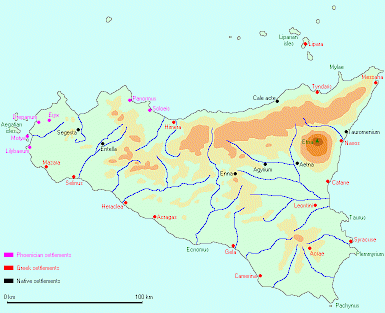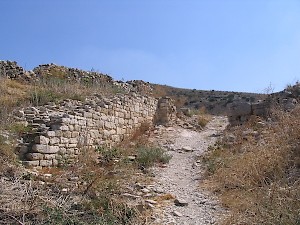Segesta
Q692847Segesta (Greek Σέγεστα, ῎Εγεστα, Αἵγεστα): town in western Sicily, best known for its temple.

Archaeologists have established that the hill that is now occupied by Segesta's theater, the Monte Barbaro, was already inhabited in the Neolithicum and Bronze Age. The Greeks were to call the inhabitants of this part of Sicily Elymians and believed they descended from Trojans who had left their homeland after their city had been sacked.
Punic and Greek settlers arrived in the eighth and seventh centuries and founded several towns. One of them, Greek Selinus, became Segesta's traditional enemy, and forced the Segestans to build a wall (sixth century) and to become allies of the Punic towns. The inhabitants, who were soon controlled from Carthage, will have appreciated their new ally, because it was conveniently situated along the land route from Motya and Drepanum in the west to Panormus (modern Palermo) on Sicily's northern shore. (Today, this road is called A29.) In 510, Segesta benefited from this alliance, when Punic soldiers helped them get rid of the Spartan adventurer Dorieus, who wanted to found a city in western Sicily.

In 427, the Athenians sent an expeditionary force to Sicily, and the Segestans concluded an alliance with Athens. Feeling strong, the Segestans went to war against Selinus -there were some disputed territories- but the powerful Syracusans sided with their fellow-Greeks, and Segesta was forced to called for help in Athens (416). The Athenians decided to send a large expedition, which ended in disaster and could not help the Segestans (415-413), which in 410 finally overcame Selinus, having called in Carthaginian help.

In the fourth century, Segesta lost its independence to Carthage, and the city was treated as an enemy by Syracusan leaders like Dionysius I (who besieged Segesta in 397), Timoleon, and Agathocles - which is remarkable, because Segesta had opened negotiations with the Greek leader. Later, the city supported Pyrrhus against the Carthaginians (276), and although the latter restored control, they could not prevent Segesta from siding with Rome in the First Punic War. They used it as a supply base during the siege of Lilybaeum and Drepanum, and gave it a great territory after the war.
In the Roman age, the countryside was exploited through villas with many slaves, and the town itself went into decline. Nevertheless, the Segestans were still in control of the sanctuary of Venus Erycina, which was restored by the emperor Tiberius.note